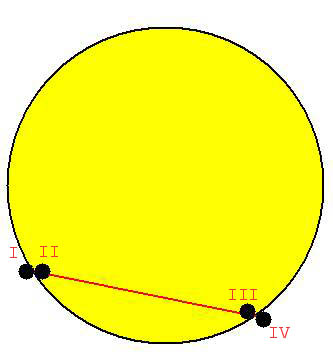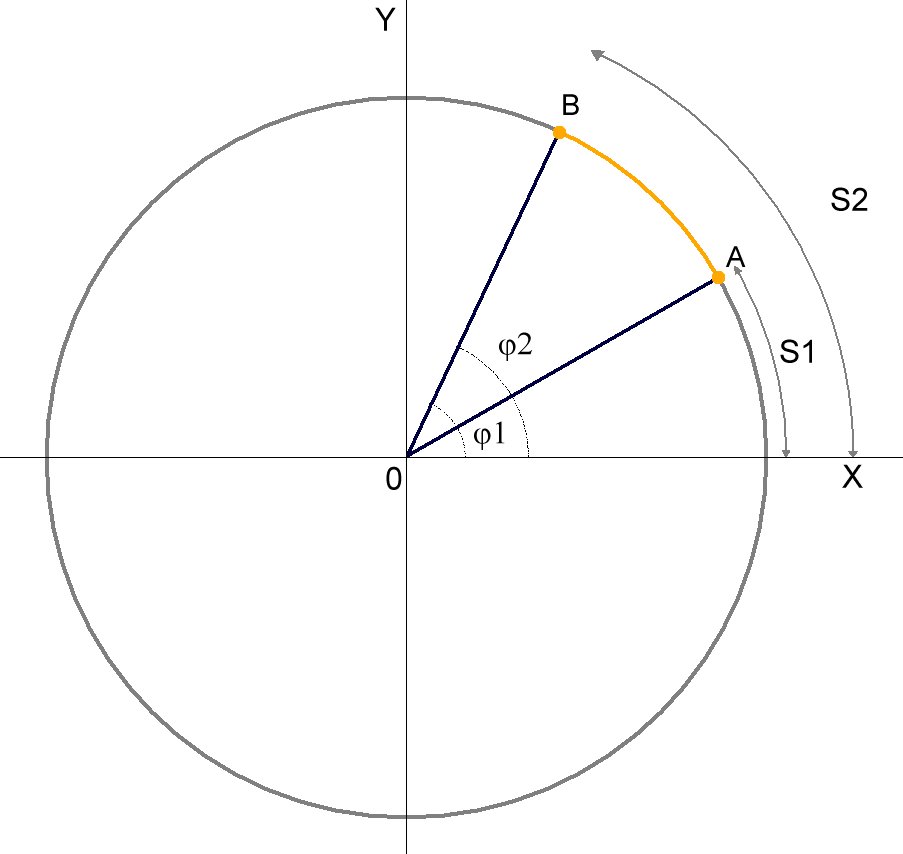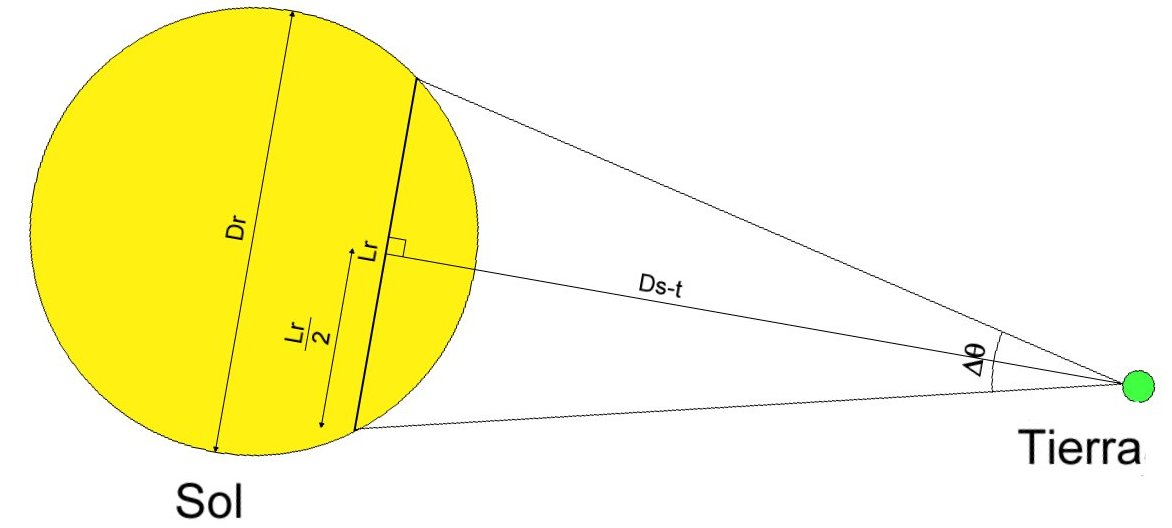
|
Other Languages: |
||
|
|
|
|
Title: 8th of June, ¡let's go to observe!
Authors: Anicet Cosialls Manonelles (46), Albert Agraz Sánchez (15), Òscar Puértolas Cabré (16), Kacper Wierzchoś (16).
High School: IES Guindàvols, Lleida, Lleida 25191
E-mail: acosialls@pie.xtec.es
|
|
|
|
|
|
|
|
|
INDEX: |
|
|
|
|
|
|
|
|
Back to Main Page |
Abstract
When we talk about a Transit of Venus, we mean that the Sun, Venus and the Earth, are alienated and in the same PLANO. Then a shadow in the Sun is projected by Venus.
On 8th of June the astronomical observation group went to Artesa de Lleida (a town near Lleida) which position is Latitude = 41,550º; Longitude = 0,700º, and its altitude is of 188 m. There the group took some photos and also took the times of the contacts.
With the images that the group took with a webcam (adapted to the astronomical observation) the group determinates experimentally the period of translation of Venus. The result that the group obtains is of 234 days, this value exceed in a 4 per cent from the value accepted by the International Community Association.
The group also tried to capture images that can prove the presence of atmosphere in Venus. The results are not completely satisfactory.
Anyway, we must say that we have cooperated with different organisations who calculate the distance between Sun and Earth, using our coordenates and the time of the contacts that we took (www.venus04.org).
Summary
The aim of this project can be divided in 3 important parts:
the first is determinate experimentally the period of translation of Venus around the Sun; the second, is demonstrate the existence of atmosphere in the planet, and, if it is possible, determinate its thickness; and the third, collaborate with the International Science Community, sharing images, times and the situation where the photos were taken.
Everything from the data obtained experimentally on 8th of June, with a catadioptrical telescope of only 90 mm, a modificated webcam (prepared to long expositions) and a computer.
The astronomical observation was done in a small mountain near Lleida, concretely in a town situated at 12km from Lleida, called Artesa de Lleida. This town is in this position: Latitude = 41,550º; Longitude = 0,700º, and its altitude is of 188 m.
The group has been able to calculate the period of translation of Venus, with only an error of the 4 per cent, but there were not clues that could demonstrate the existence of atmosphere in Venus.
Main Part
QUESTIONS
Using the photos and the notes that the group took the day of the Transit of Venus (8th of June of 2004), using a catadioptrical telescope and a modificated webcam, the group tries to answer the following questions:
Problem I: Is possible determinate, experimentally, the period of translation of Venus around the Sun?
Problem II: Is possible take photos of Venus' atmosphere?
Problem III: Is possible determinate thickness of Venus' atmosphere?
PREVIOUS KNOWLEDGE
In this part we are going to expose all the concepts that the reader shall know to be able to understand this essay, and to be able to learn from it.1.- What is a Transit and why it is produced?
A transit is the way that a planet or other object does in front of the Sun. Only Mercury (fig. 1) and Venus (fig. 2) are nearer than Earth from the Sun, so only they can transit in front of the Sun. We must admit that the Moon can do it, too. When that happens, it is called Solar Eclipse.
|
|
|
|
Fig.1 |
Fig.2 |
We must observe that a Transit can not be seen in the same way by two observators that are placed in different locations (fig. 3) and this phenomenon has been used to calculate the distance between Earth and Sun, because we can observe that as nearer to the Ecuador we are, the Transit lates more.
What is seen from Earth, is only the projection of the Venus's shadow on the Solar Disc.
In the next image, there are two shadows of Venus (A' and B') seen by two observators (A and B) who are placed in the same latitude but different longitude.

Fig.3
In a transit, the object, makes four contacts with the Solar Disc, well, really it is its shadow who makes it (fig. 4). The first (and the most difficult to see) is when the object starts the transit in front of the Solar Disc (I, fig. 4), the second contact (II, fig. 4) is when the last part of the object is completely inside the Solar Disc, the third contact (III, fig. 4) is produced when the first part of the object starts making contact with the end of the Sun, and the fourth contact (IV, fig. 4) is when the object is completely out of the Solar Disc.

Fig.4
If the orbits of the planets Mercury, Venus and Earth, meet in the same plane, the Transits of those planets would be more frequents, so Mercury would transit three times per year and Venus every two years. However, it does not happen in that way, so Venus only transit every 122 years, and once one transit has passed, it would repeat in 8 years, and another time 122 years.
EVERYBODY MUST LOOK AT THE SUN WITH THE CORRECT PROTECTION.
2.-Making a little bit of history
Following the transits of Venus and Mercury has been possible because of Johannes Kepler, who enunciated the laws that describe the movement of the planets. Kepler was the first person who predicted a transit, concretely the Mercury transit on 7th of November of 1631 and the Venus transit on 7th of December of 1631.
The first Transit of Venus was observed in 1639, because before that year, the knowledge of the scientists was not enough to make such a great moment. Not many years ago, the transit of Venus were very important because they were the way to calculate the distance between Sun and Earth (the Astronomical Unit). Between XVIII and XIX centuries, many scientists organized lots of expeditions to observe those phenomenons, and they tried to calculate the Astronomical Unit. Actually, the transits are not very important in that way, because the distance has been calculated by other ways.
3.-Characteristics of Venus
|
Nowadays we have this information about Venus, because lots of espacial missions have gone there.
|
|
|
Mass = 0,815earth masses
Equatorial diameter = 12.102,8 km
Average Density = 5,25g/cm³
Rotation period = 243 days |
Translation Period = 225 days
Average distance to Sun = 0,7233 AU
Orbital eccentricity* = 0,0068
Orbital inclination = 3,4º |
|
*Knowing that the Orbital Eccentricity is nearly 0, the group will consider the orbit completely circular. |
|
4.- Physics of the Circular Movement
|
A Circular Movement (c.m) is a movement where the object that is moving describes a circular trajectory, so, it is a movement in two dimensions. Describing this phenomenon using cartesians coordenates is difficult, so, a system that uses polar coordenates (fig. 5) is used. To give the position of the object using this system, two values must be given; one is the distance from the center of coordenates to the object (r) and the other is the angle that form the straight r and the horizontal semi straight right (origin of the angles), called φ and it is measured in radians.
To measure the way of the
object, the increment of the angle is used, which we will obtain with the
following operations: With the way of the object and the time that this object lated to cover the way, the Angular Velocity can be calculated, using the following operations:
Where Dj is the increment of the angle and Dt is the increment of time.
|

fig. 5 |
If the angular velocity (w) is constant, we can talk about a Constant Circular Movement. This movement is periodic, so his angular velocity can be expressed by the period (T). Knowing that in a period of time (DT) equal to the period T, the object has an angular way of 2p rad, so we can say that:

EXPERIMENTAL DESIGN
Experiment I:
Knowing that the elepticity of the orbit of Venus is nearly 0, we can consider that it's movement is circular.
With the aim of calculating the period of translation of Venus, we are going to do the following.
Material:
- Telescope Meade ETX-90EC
- Solar Filter type Braader of Thousand Oaks
- Oculars de 26 y 9,7 mm Meade
- Focal Reductor of 0,6x to reduct the augments of the telescope
- WebCam Philips TouCam Pro 740K
- Laptop Pc Toshiba Satellite 4300 Series with Windows 98
- Software: K3CCD Tools image taker software.
- Software: Registax image processor software.
- Software: Adobe Photoshop image enhancement software.
- Stopwatch sinchronized with the universal time ( ±1 s of error)
Methods:
1.- At 6:30 of the 8th of june of 2004 the telescope is mounted.
It is put in station, it means, the tripod looking to the north (a compass will be needed) and then the base of the tripod is inclined 41º, which is the latitude of Artesa de Lleida (our observation place).
2.- The transit is observed and the times of the contacts written in a paper. With the stopwatch.
3.- The time of the Transit is the difference between the first and the last contacts.
4.- Using the photos of the transit, the way of transit over the Sun is marked. This process can be done with Adobe Photoshop. The process is based in fusionate two or more images where the only difference shall be the time. Those images may be collocated on over other adding a layer in the first one, and then, the outlines of the Sun, with the tool "move".
5.-The way of Transit is measured (apparent longitude La). To do that we act in this way: we make a line pas over the two venus shadows of the image that we obtained in the previous section. This line shall be done with one different colour of the ones in the picture, and then we select it with the RGB valor. Then we cut it and paste it in other file. And then we measure the longitude of the line.
6.- We measure the apparent diameter of the sun (Da). We select the image with all the solar disc on it, using the RGB valor. To do that, we must select the tool "varita magica", and make click over the space. Then invert selection and copy. Then paste it in a new file, and look how many pixels has it got.
7.- Knowing the real diameter of the Sun (Dr=1392000 Km.), we determinate the real longitude (Lr) of the way of venus. We make an easy extrapolation to know the real longitude in km of the way of Venus.
8.- We determinate the way of Venus ( Dq ) using the distance Earth-Sun (Ds-t) and the longitude of the way of Venus (Lr) (fig. 6). To do that we will use the next operations:



Fig.6
9.- Using the angular way (Dq) and the time of the Transit (Dt) the angular velocity is determined (w=Dq/Dt). It's necessary to remember that Dt is the difference between the first and the fourth contacts.
10.- Using the angular velocity the period of translation is determined, using the next expression:
T = 2p/w
Picture of the Methods:

Fig. 7
Experiment II:
The aim of this experiment is to detect the atmosphere of Venus taking into account obtained images during the astronomical observation and their digital enhancement.
It will be logic to think that we will see a circular halo around the planet, which could indicates the presence of Venus atmosphere because this atmosphere is very dense.
Material:
-PC Laptop Toshiba Satellite 4300 Series with Windows 98
-Software: Adobe Photoshop image enhancement software.
Methods:
1.-Search the image made by our work group, where we could see any indice of the Venus atmosphe presence, like a lighter halo around the planet disc
2.-Open the image with Adobe Photoshop and enhance the image resolution
3.-Aply zoom in the outer halo (if present).
4.-Note the halo characteristics, e.g.: it is circular?; it corresponds to the zone where atmosphere could be present?
5.-Decide if we have enough evidences of the Venus atmosphere halo presence around the planet and why.
Picture of the Methods:

Fig. 8
Experiment III:
Taking account the apparent diameter of Venus, the apparent wide of its atmosphere and the real diameter of Venus, we would determine the real wide of the Venus atmosphere.
Material:
-Laptop Pc Toshiba Satellite 4300 Series with Windows 98
-Software: Adobe Photoshop image software.
Methods:
1.-Obtain the image where we can observe the Venus atmosphere.
2.-Open the image with Adobe Photoshop.
3.-Select the non solar disc zone using the option “varita mágica” in the Spanish version, only have to click in one zone that is not the in the solar disc
4.- Invert the selection
5.-Copy the selection and paste in a new image.
6.-Know the size of the image in pixels, if it's in centimetres, go to the step 8.
7.- Know the pixels per inch of the screen, looking in Screen Properties>Configuration>Advanced options and making an easy conversion factor:
![]()
8.- Return to the original image and make it's resolution 200
9.- Apply Zoom into Venus and it's atmosphere,
10.- Make a line of any colour that isn't appreciable on the image (e.g. green). This line should connect the end of Venus and exterior end of Venus atmosphere.
11. Select this line by tool: “Varita Mágica”.
12. Copy and paste the selection in new image. Take a care about dimensions of a new image.
13. Put the image in horizontal position and take a care in “Image properties” about the wide of the image (in cm or in pixels). If you have it in cm forgot about step 14.
14. Use following conversion factor.
![]()
15. Once you have the value of apparent Sun diameter and apparent wild of the atmosphere, use following conversion factor for calculate the real atmospheric wide.
![]()
OBTAINED RESULTS, ANALYZE AND DISCUSSION
Experiment I:
In this experiment, it was very important measure the contact times, for the calculation af the angular speed of the planet.
|
Contacts |
Time (UT) |
Image |
|---|---|---|
|
I |
05:21:15 |
|
|
II |
05:40:20 |
|
|
III |
11:04:59 |
|
|
IV |
11:24:35 |
|
|
For the calculation of the translation period of Venus, it's necessary to make the following steps: 1.- Calculate the apparent sun diameter (Da) in centimetres:
2.- Calculate the apparent longitude of the Venus path (La) in centimetres:
3.- Calculate the real longitude of the path (Lr) comparing this with the diameter of the sun.
4.- Calculate the angular displacement (Dq):
|
5.- Calculate the time increasement (Dt):
6.- Calculate the angular speed (w):
7.- Calculate the period in seconds:
8.- Calculate the period in days:
9.- Calculate the relative error:
|
Experiment II:
|
The results of this experimentnt are unclear because therefore it's possible to see the halo around the planet shadow but it does not seems to be the Venus atmosphere halo effect. |
|
|
This halo is probable a result of aberration of the CCD chip of the web cam. This aberration might appear by the difference of the high level contrast, (bright yellow and dark black). The halo is not circular and is appearing only in two symmetrical sides of the Venus shadow, like a ( ). Very unclear result. |
Fig. 8 |
Experiment III:
The result of the second experiment is very unclear so it's impossible to calculate the Venus atmosphere wide.
CONCLUSIONS
Taking into account the results, we are in conditions to afirmate that:
1.- The astronomical study of the Venus Transit, makes posible the determination of the translation period of the planet.
2.- The translation period of Venus is 234 days. The real value is 225 days so the relative error of the determination is only a 4%.
3.- We can't determine evidently the Venus atmosphere presence in form of the halo around the Venus shadow, so we can't calculate the wide of the Venus atmosphere.
4.- The times of the contacts have been shared with other people to calculate the distance between Sun and Earth (www.venus04.org).
Photo Gallery
|
- Hacer click para ver las imágenes ampliadas - |
|||
|
1st Contact |
2nd Contact |
3rd Contact |
4th Contact |
|
Moment before |
Moment after |
Transit of Mercury 5-7-03 |
Venus |
|
Medium moment |
Moment before the 2nd Contact |
Solar Disc with |
GIF of the end |
References
S. Serra, J. Mercadé, M. Armengol. Física. editorial McGraw Hill, 2002.
Tribuna de Astronomía y Universo, II Época Nº 59-mayo 2004.
Gran Larousse Català, edicions 62, marzo 1990.
Informative dossier about Transit of Venus by UB.
CD-ROM about the Transit of Venus by Física en Acción.
FINAL NOTE: All the images in this essay have been done by members of the work team wiht a Meade ETX-90 telescope and a webcam Philips TouCam Pro, there are also images done with a Sony DSC-P120 and with a Sony DSC-V1.